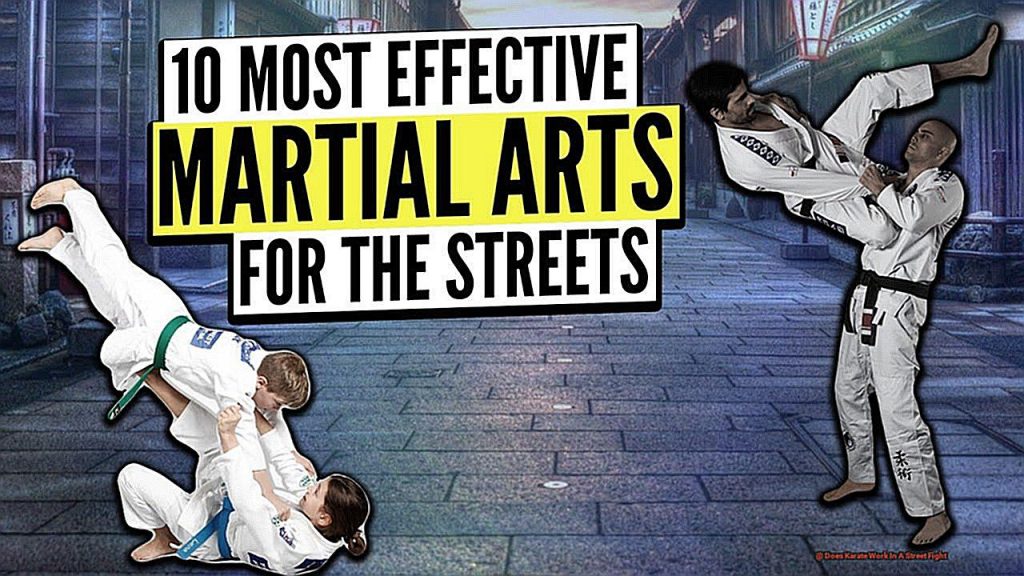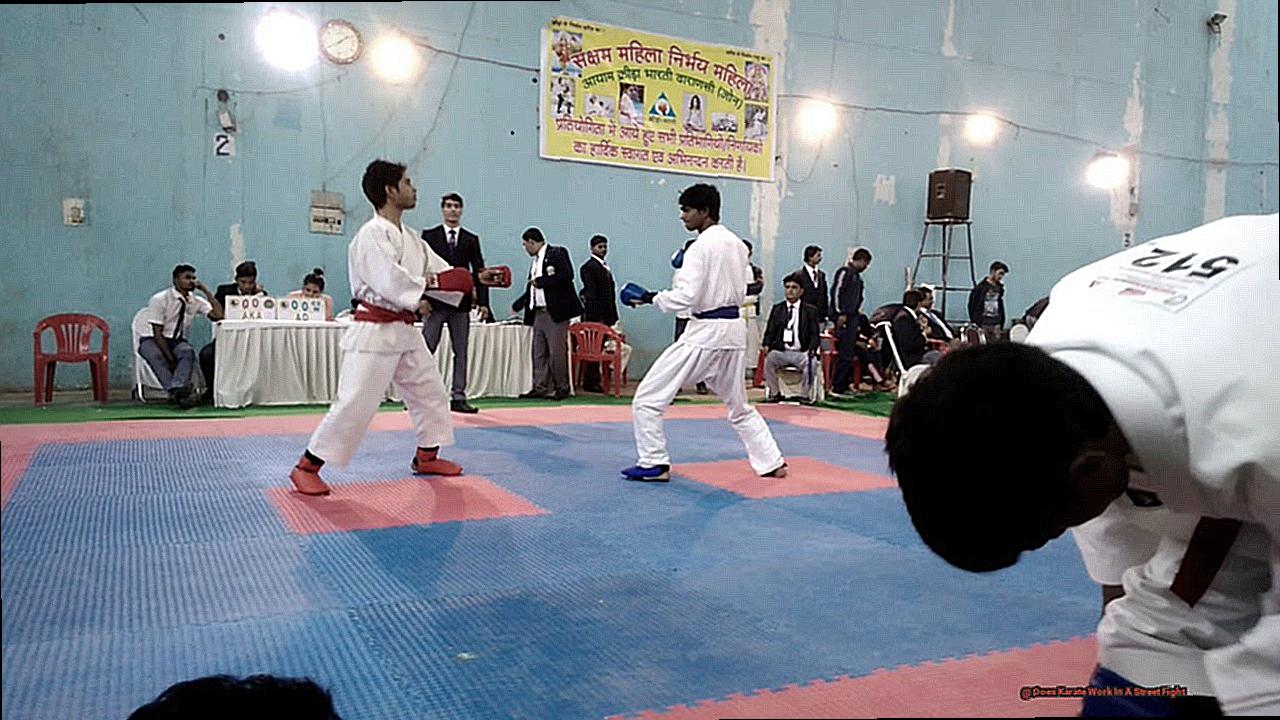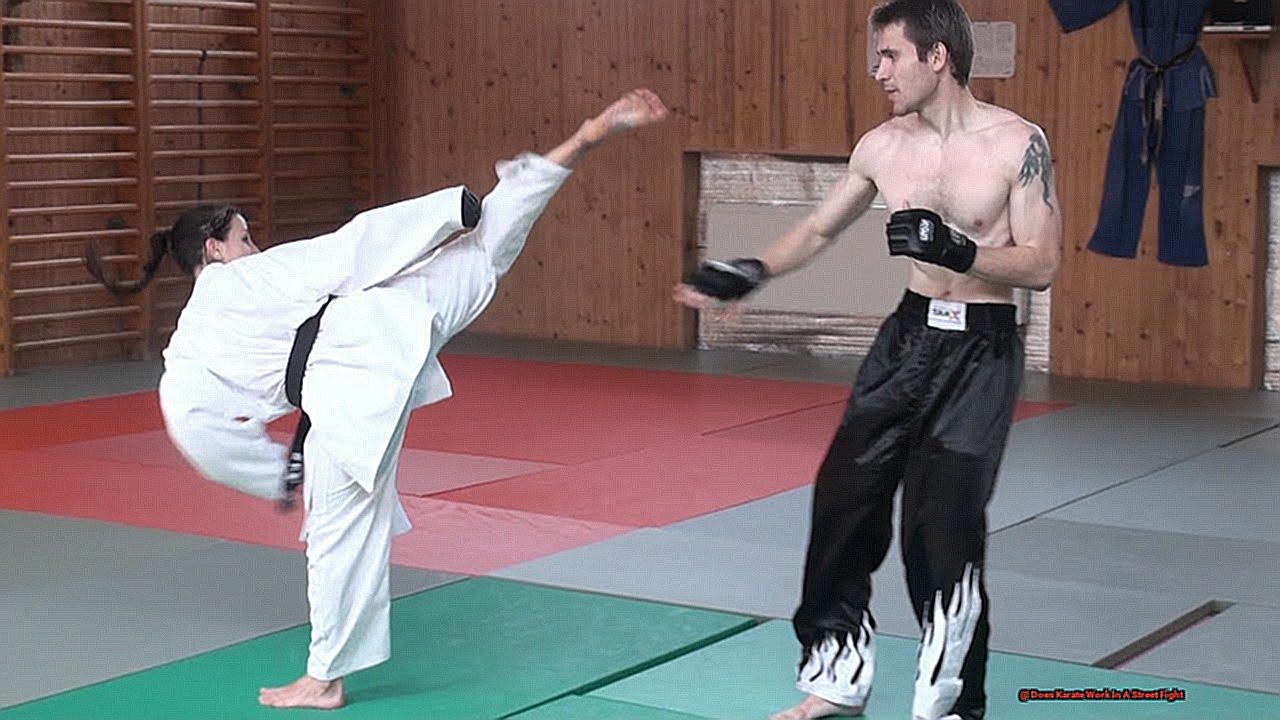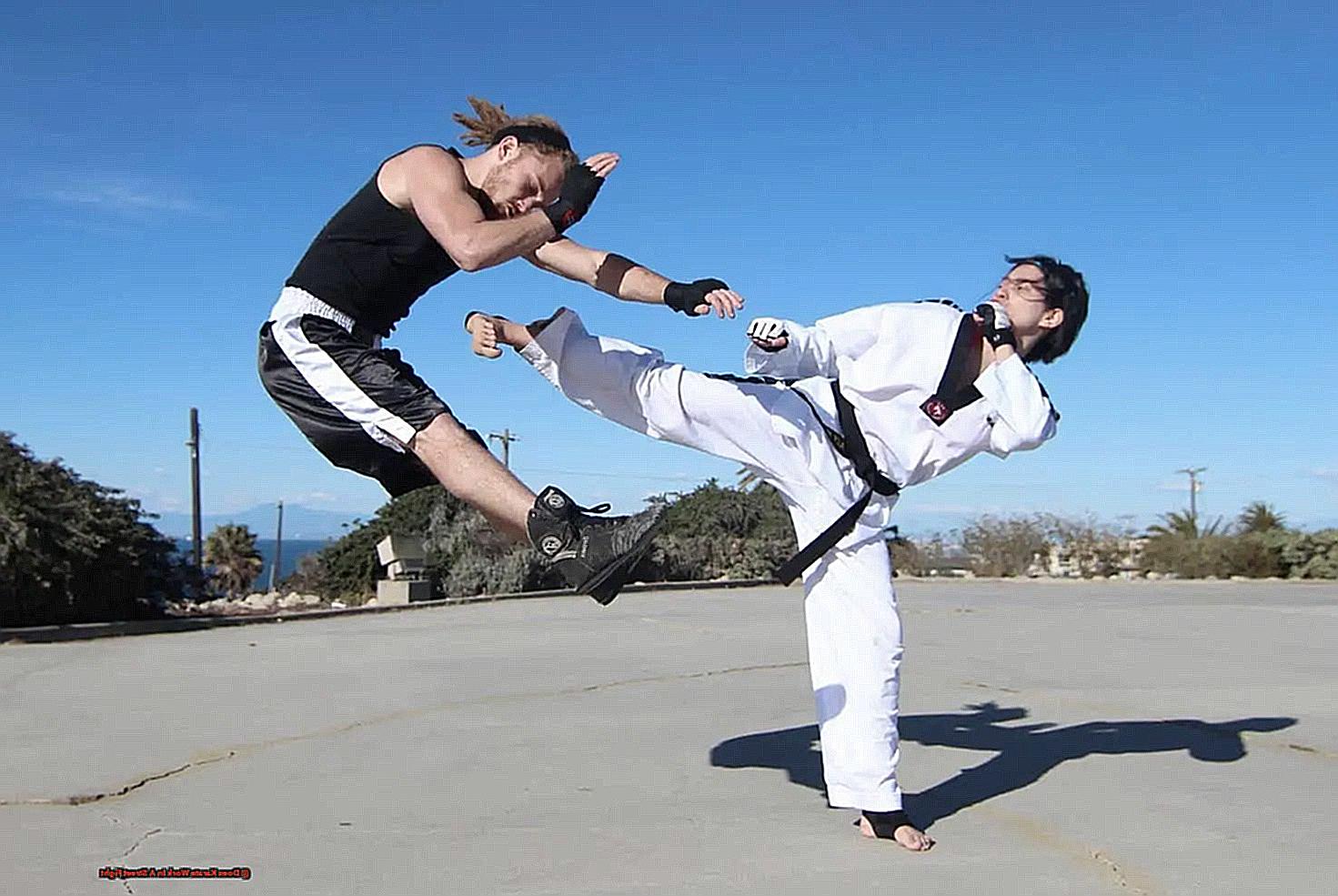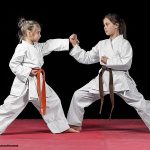Are you tired of feeling like an easy target in potential street fights? Do you want to feel confident and prepared in any situation? Well, it’s time to consider the ancient art of karate. Not only is it a popular form of self-defense, but it also offers numerous physical and mental benefits. But what sets karate apart from other martial arts when it comes to street fights? Let’s delve into some key points:
- Karate focuses on practical and efficient techniques that can be applied in real-life scenarios.
- Its emphasis on discipline and control helps individuals remain calm and collected in high-pressure situations.
- The use of striking, kicking, and grappling techniques makes it a versatile form of combat.
- The physical training involved in karate builds strength, agility, and endurance.
- The mental aspect of karate teaches individuals to assess threats and respond accordingly.
In this blog post, we’ll take a closer look at how the principles and techniques of karate make it an effective tool for self-defense on the streets. So put on your gi and get ready to discover the power of karate in street fights.
Taekwondo
Taekwondo is an extremely efficient form of self-defense in street confrontations due to its focus on speed and agility. However, it’s important to note that its effectiveness may vary depending on the practitioner’s physical and mental capabilities. Compared to other martial arts, Taekwondo stands out in the following ways:
| Martial Art | Strengths | Limitations |
| Taekwondo | – Emphasis on swiftness and nimbleness. – Highly effective kicking techniques. – Agile footwork and evasion skills. – Training in punching and blocking. |
– Focuses mainly on striking techniques, making practitioners susceptible to grappling techniques. – Requires a high level of physical fitness and flexibility. – Practitioners must possess strong mental abilities to effectively apply its techniques in real-life situations. |
| Judo | – Highly effective grappling techniques. – Utilizes an opponent’s strength against them. – Teaches how to take down an attacker without causing harm. |
– Lacks striking techniques and may not be as useful in self-defense scenarios. – Requires close proximity to the attacker, which may not always be possible in street fights. |
| Karate | – Focuses on powerful strikes. – Trains practitioners in hand-to-hand combat. – Emphasizes discipline and mental strength. |
– May not be as effective against larger opponents. – Some schools lack practical training for real-life situations. |
| Boxing | – Intuitive and effective punching techniques. – Emphasizes footwork, timing, and speed. – Good for close-quarters combat. |
– Focuses solely on punching, leaving practitioners vulnerable to other forms of attacks. – Does not train for grappling or takedowns. |
| Wrestling | – Fast-paced and explosive takedowns. – Utilizes an opponent’s momentum against them. – Emphasizes strength and conditioning. |
– Lacks striking techniques. – Limited in self-defense scenarios as it requires close proximity to the attacker. |
| Muay Thai/Kickboxing |
Combat Sambo
Combat Sambo is widely recognized as a highly effective form of martial arts in street fights. This is due to its adaptable and practical techniques, which have been tested and proven in real-life combat situations. In comparison to other forms of martial arts, Combat Sambo sets itself apart by emphasizing both striking and grappling techniques, making it an all-encompassing combat system.
The following table displays the key strengths and weaknesses of Combat Sambo when compared to other popular forms of martial arts:
| Martial Art | Strengths | Weaknesses |
|---|---|---|
| Combat Sambo | – High focus on both striking and grappling techniques – Practical and effective in real-life combat situations – Allows for adaptability and versatility in different scenarios |
– Limited emphasis on traditional techniques and forms – Requires a high level of physical fitness and conditioning – May not be as well-known or widely available as other forms of martial arts |
| Taekwondo | – Quick and agile techniques – Strong emphasis on kicks – Promotes discipline and mental strength |
– Limited focus on grappling and self-defense techniques – May not be as effective against larger or stronger opponents – Requires a high level of flexibility and coordination |
| Judo | – Emphasis on throws and takedowns – Effective in close-range combat – Focus on leveraging an opponent’s strength against them |
– Limited focus on striking techniques – May not be as effective against multiple attackers – Requires significant training and skill development for mastery |
| Karate | – Versatile striking techniques – Emphasis on speed, power, and precision – Promotes discipline and mental focus |
– Limited focus on grappling and ground fighting – May not be as effective against larger or stronger opponents – Requires significant training and skill development for mastery |
| Boxing | – Strong emphasis on punching and footwork – Effective in close-range combat – Promotes physical fitness and endurance |
– Limited focus on kicks, grappling, and self-defense techniques – May not be as effective against multiple attackers – Requires significant training and skill development for mastery |
| Wrestling | – Strong emphasis on takedowns and ground control – Effective in close-range combat – Focus on leveraging an opponent’s strength against them |
– Limited focus on striking techniques – May not be as effective in stand-up fighting scenarios – Requires significant training and skill development for mastery |
| Muay Thai/Kickboxing |
Karate
Karate is a formidable form of self-defense in real-life street fight situations due to its practical techniques and emphasis on attacking. Unlike modern karate styles, traditional karate styles have no restrictions on where you can strike, making them more effective in street fights. Moreover, karate’s stand-up fighting technique allows for swift and powerful strikes, making it a valuable tool for close-quarters combat.
Sub-Heading: Differences between Traditional and Modern Karate Styles
| Traditional Karate Styles | Modern Karate Styles |
| Developed for practical combat situations | Designed for sports competitions with limitations and rules |
| Emphasize attacking over strength | Focus on strength and conditioning |
| Incorporate practical techniques for close-quarters combat | Lack practicality and prioritize aesthetic movements |
| No restrictions on striking areas | Limitations on striking during competitions |
The Effectiveness of Traditional Karate Styles in Street Fights
Traditional karate styles like Uechi-Ryu, Shotokan, and Goju-Ryu are highly effective in street fights due to their emphasis on practical techniques and attacking. These styles were developed specifically for real-life combat situations, without any restrictions on striking areas. This makes them ideal for self-defense in unpredictable and chaotic street fight scenarios.
Furthermore, traditional karate styles utilize a stand-up fighting technique that allows for quick and powerful strikes. This is crucial in close-quarters combat where there is limited space to maneuver. In contrast, modern karate styles often prioritize aesthetic movements and lack practical techniques for close-quarters combat.
The Importance of Physical Fitness in Karate
While traditional karate styles are effective and practical in street fights, they do require physical fitness. This is because karate places a strong emphasis on agility, speed, and coordination in its techniques. A physically fit practitioner will have an advantage in a street fight as they can execute techniques with more power and precision.
In conclusion, traditional karate styles are highly effective in real-life street fight scenarios due to their practical techniques and focus on attacking. They offer versatility and adaptability in close-quarters combat situations and have no restrictions on striking areas.
Judo
Judo and karate are two popular martial arts known for their effectiveness in self-defense. While karate is all about powerful strikes and causing harm to the opponent, Judo puts more emphasis on using an opponent’s strength against them and controlling the fight. Depending on an individual’s skill level and the situation at hand, both martial arts have their own strengths and weaknesses when it comes to street fights.
Strengths of Judo:
- Teaches grappling and ground fighting techniques, which are crucial in close-quarter situations or when a fight ends up on the ground.
- Utilizes an opponent’s strength and momentum to throw them off balance and gain control of the fight.
- Instructs techniques for incapacitating an opponent without causing severe harm, making it useful against unskilled aggressors.
Strengths of Karate:
- Focuses on powerful strikes and kicks, making it effective in inflicting harm on the opponent.
- Teaches techniques for defending against various attacks, including strikes, grabs, and holds.
- Emphasizes discipline and mental focus, enabling practitioners to stay composed in high-stress situations.
Comparison Table:
| Judo | Karate | |
| Main Focus | Controlling the fight by using an opponent’s strength against them | Inflicting harm through strikes and kicks |
| Techniques Taught | Grappling, throws, joint locks, takedowns | Strikes, kicks, blocks, evasions |
| Emphasis on Ground Fighting | Yes | No |
| Emphasis on Striking | No | Yes |
| Mental Focus and Discipline | Not as emphasized as in karate | Highly emphasized |
| Use in Street Fights | Effective against unskilled opponents; useful for controlling and incapacitating without causing severe harm | Effective in close-quarters combat, but may cause more severe injuries to opponents |
When it comes to effectiveness in street fights, both Judo and karate have their own strengths and weaknesses. Judo is better at controlling the fight and using an opponent’s strength against them, making it useful in close-quarter situations.
On the other hand, karate focuses more on causing harm to the opponent through powerful strikes and kicks.
Boxing
When it comes to street fights, it’s important to know the strengths and weaknesses of different martial arts. In this comparison of boxing and karate, we will explore how each fares in real-life scenarios.
Boxing is known for its focus on punching techniques. Quick footwork and head movement are also emphasized to evade attacks. Training primarily focuses on building explosive power and stamina to deliver powerful blows. However, there is no specific training for ground fighting or grappling, and joint locks or submissions are not taught.
On the other hand, Karate utilizes a variety of striking techniques, including punches, kicks, elbows, and knees. Balance, coordination, and flexibility are also emphasized in addition to explosive power. Mental focus and discipline are core principles in training. Unlike boxing, Karate teaches effective self-defense techniques, including ground fighting and wrist grabs. Additionally, joint locks and submissions are taught for self-defense purposes.
Overall, while both martial arts can be effective in street fights, karate may have an edge due to its emphasis on self-defense techniques, mental focus, and overall versatility in striking techniques.
Wrestling
Karate is a form of martial arts that focuses on striking techniques using hands and feet, but it also includes elements of grappling and wrestling. These techniques are crucial for preparing individuals for real-life street fights as they often involve close-quarters combat and grappling situations.
The incorporation of wrestling techniques in karate contributes to its effectiveness in a street fight in multiple ways:
- Close-quarters combat: In a street fight, there is no space or boundaries to create distance between opponents. This means that the fight will most likely take place in close quarters where striking techniques may not be as effective. However, by integrating wrestling techniques into karate, students can effectively defend themselves and control their opponent in these situations.
- Control and takedowns: Karate training teaches students how to control their opponent’s movements and bring them down to the ground. This can be crucial in a street fight where the goal is not necessarily to knock out an opponent but to gain control and end the fight quickly.
- Ground fighting: While traditional karate may not focus on ground fighting as much as other martial arts like Brazilian Jiu-Jitsu or wrestling, it does incorporate some elements of ground fighting into its training. This gives karate practitioners an advantage in street fights that end up on the ground.
- Versatility: The integration of wrestling techniques in karate makes it a more well-rounded martial art. This versatility allows students to adapt to different opponents and situations in a street fight, making them more effective overall.
So, the use of wrestling techniques in karate plays a significant role in its effectiveness in a street fight.
Muay Thai and Kickboxing
When it comes to street fights, the techniques used in Muay Thai and Kickboxing differ greatly from traditional karate. They incorporate a diverse range of hand strikes, kicks, clinching, grappling, and kata practices, setting them apart from the more rigid and structured approach of karate. This allows Muay Thai and Kickboxing to be more successful in handling the unpredictability and chaos that often accompanies street fights.
One of the main differences between Muay Thai and Kickboxing compared to traditional karate is the emphasis on hand strikes. While karate primarily focuses on punches, Muay Thai and Kickboxing utilize a wider range of hand strikes, including elbows and palms. These techniques are highly effective in close combat situations, providing more options for defending oneself in a street fight.
Additionally, both Muay Thai and Kickboxing heavily rely on powerful kicks as one of their main forms of attack. Unlike karate, which typically uses kicks as a finishing move, Muay Thai and Kickboxing incorporate kicks throughout their entire fighting style. This allows for a more dynamic approach to fighting, making it easier to adapt to different situations that may arise in a street fight.
Moreover, clinching and grappling are also essential components of Muay Thai and Kickboxing, setting them further apart from traditional karate. While karate may incorporate some forms of grappling, it is not as prominent as it is in Muay Thai and Kickboxing. These techniques provide an advantage in close combat situations, allowing for greater control over the opponent’s movements.
Lastly, the use of kata practices in traditional karate differs greatly from the unpredictable nature of street fights. While kata may help with overall technique and discipline, it may not always be effective in real-life scenarios. On the other hand, Muay Thai and Kickboxing focus on practical fighting techniques that can be applied in chaotic situations.
Jiu-Jitsu
Jiu-Jitsu, a highly effective martial art in street fights, has unique characteristics that set it apart from other styles.
Firstly, unlike other martial arts that prioritize striking and standing techniques, Jiu-Jitsu focuses on ground fighting and grappling. This approach is based on the belief that a smaller and weaker individual can defend themselves against a larger and stronger opponent by using leverage and proper techniques. In a street fight, where there are no rules, this makes it a highly effective strategy.
Moreover, Jiu-Jitsu is known for its practical fighting techniques, specifically designed for real-life situations. This means that practitioners are trained to defend themselves in various scenarios, such as being attacked from behind or pinned down on the ground. It also teaches techniques to escape from common attacks like headlocks and bear hugs.
In contrast to other martial arts that focus on causing harm, Jiu-Jitsu prioritizes control through submissions. These techniques involve manipulating joints or applying pressure to sensitive areas of the body to force the attacker to submit. This makes it a more humane approach to self-defense, especially in street fights where excessive force can have serious consequences.
Another key difference between Jiu-Jitsu and other martial arts is its emphasis on street readiness. Practitioners are trained to handle real-life situations where there are no rules or referees to intervene. They learn how to defend themselves in close quarters, against multiple attackers, and in various environments.
| Technique | Jiu-Jitsu | Other Martial Arts |
| Focus | Ground fighting and submissions | Striking and standing techniques |
| Training for real-life situations | Yes | Not always |
| Humane approach to self-defense | Yes | No |
| Street readiness | Highly emphasized | Not always |
Jiu-Jitsu’s unique emphasis on ground fighting, practical techniques, and street readiness make it a standout martial art for street fights.
Krav Maga
Krav Maga, a martial art developed by the Israeli Defense Forces (IDF), is a practical and efficient fighting style that is highly effective in street fights. It combines techniques from various disciplines, making it a well-rounded and adaptable form of self-defense. Unlike traditional martial arts, Krav Maga focuses on real-life scenarios, preparing practitioners to defend against common street attacks such as punches, kicks, chokes, and grabs.
One of the key differences between Krav Maga and other martial arts is its emphasis on practical self-defense. While other forms may prioritize competition or sport, Krav Maga is solely focused on equipping individuals with simple and effective techniques for real-life situations. This makes it an ideal fighting style for street fights, where flashy movements or complex forms are not practical.
Moreover, Krav Maga also prepares practitioners for unpredictable situations that may arise in a street fight. In these scenarios, there are no rules and anything can happen. To ensure their safety, Krav Maga trains individuals to be ready for any situation and use whatever means necessary to defend themselves. This includes using everyday objects as weapons or taking on multiple attackers.
In conclusion, the effectiveness of Krav Maga lies in its simplicity and versatility. Its focus on real-life scenarios, combination of techniques, practical self-defense methods, and preparation for unpredictable situations make it a highly effective form of self-defense in street fights.
MMA
MMA, which stands for Mixed Martial Arts, is a full-contact combat sport that combines techniques from various martial arts. It has gained widespread popularity through events like the UFC (Ultimate Fighting Championship) and is widely regarded as one of the most effective forms of self-defense. In contrast, karate is a traditional Japanese martial art that emphasizes striking with hands and feet. Although both MMA and karate have their strengths and weaknesses, MMA is generally considered more practical and applicable in real-life situations due to its emphasis on practicality and real-world scenarios.
This is not to say that karate is ineffective in street fights, but its training methods and focus on precision and technique may not always translate well in real-life situations. The liberal ruleset of MMA also allows for a wider range of techniques to be used effectively in street fights compared to the more restricted ruleset of traditional karate competitions.
However, it’s worth noting that some of the most successful MMA fighters have backgrounds in karate and incorporate its techniques into their fighting style. This demonstrates the effectiveness of traditional martial arts in modern combat sports.
In conclusion, while both MMA and karate have their strengths and weaknesses, MMA is generally considered more practical and effective in street fights due to its emphasis on real-life scenarios.
Conclusion
In conclusion, when it comes to defending yourself in a street fight, karate is an excellent choice.
Its practical techniques, emphasis on discipline and control, and rigorous physical training make it a formidable combat system. Unlike some martial arts that may have limitations in real-life situations, karate’s well-rounded approach with striking, kicking, and grappling techniques makes it highly effective.
Don’t hesitate any longer – start your journey in karate today and gain the confidence and skills to protect yourself in any situation.

